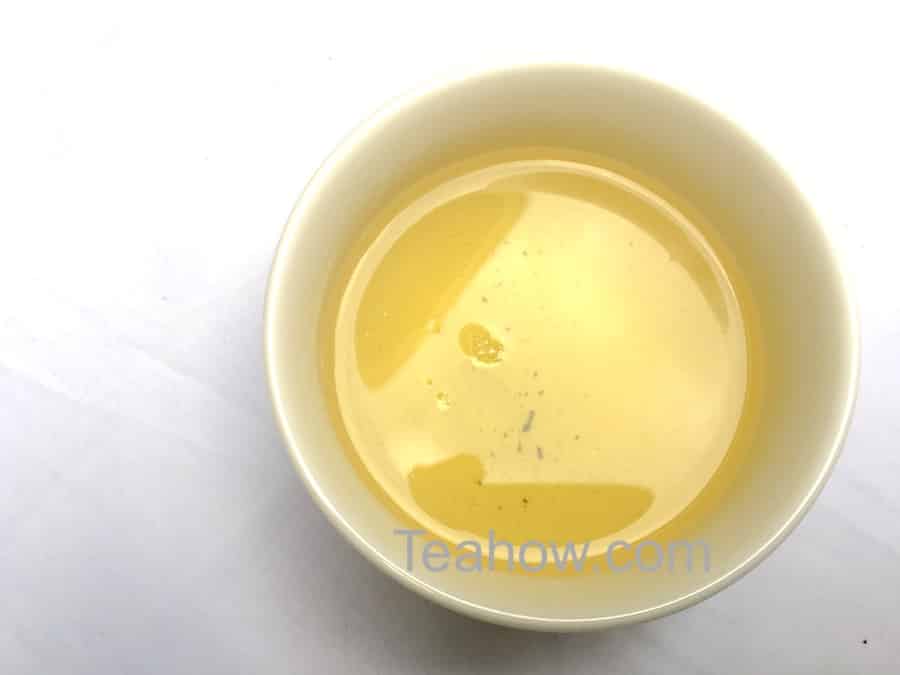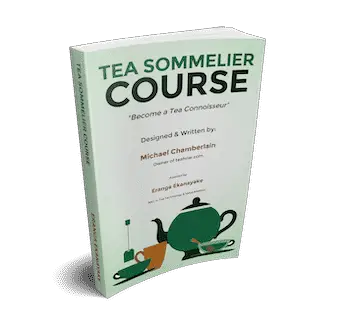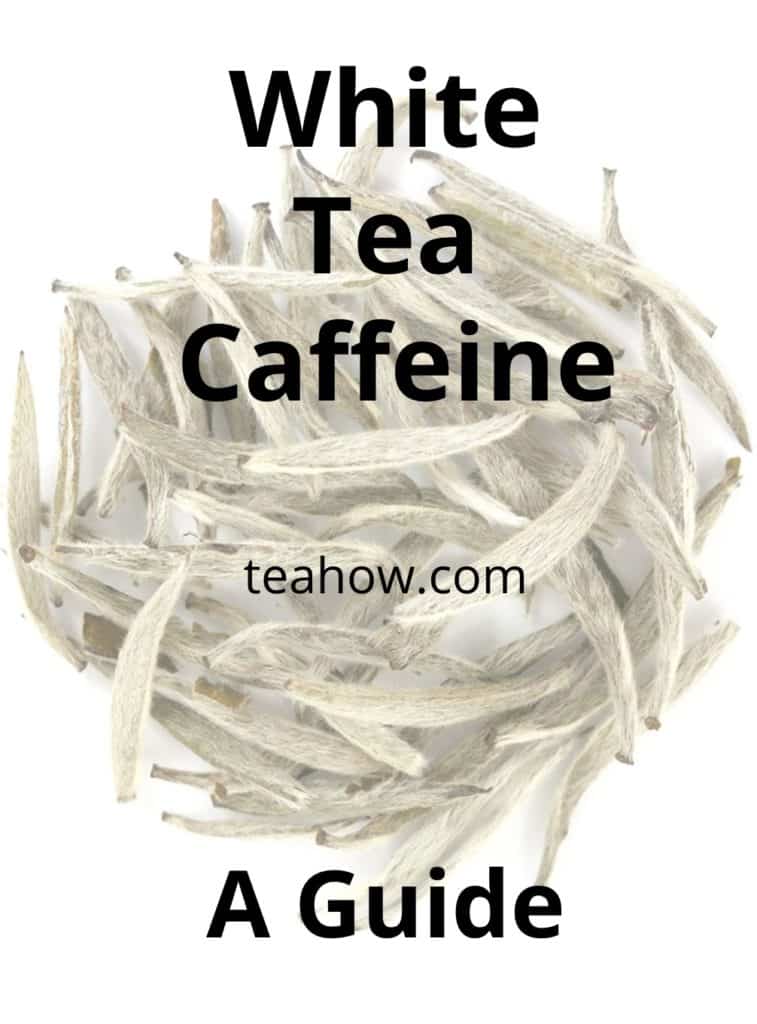So you’re wondering about the amount of caffeine in White tea, I’ve written a lot about caffeine content in other types of teas, so check out my other articles on those listed below. But as for White tea caffeine, let’s get into the details…
White tea has 6mg – 75mg of caffeine per cup. White tea is made from the tippy buds, or young leaves of the tea plant, which contain higher caffeine levels to act as a pesticide at early growth stages. Because of this, authentic high-quality white tea can even have higher caffeine than black tea.
So exact caffeine content depends on many factors. As well as the caffeine content of the tea, I explore white tea in greater detail in my White tea 101 article.
But here, let’s explore the caffeine in White tea further…
The caffeine content in White tea
The caffeine in White tea – or perhaps any tea is difficult to specify in exact figures. Because the caffeine content in white tea can vary depending on a number of factors. And the same applies to all teas.
However, based on lab experiments carried out previously, the average caffeine content in white tea is known to range between as low as 6mg to high as 75 mg per cup (8oz).
So white tea has the potential to have the lowest or highest caffeine content when compared to other types of tea.
But as a general rule, authentic white tea will have a higher average caffeine content than other types of tea.
Caffeine should also not be confused with tannin content, tannin is a separate aspect of tea. And it bears no correlation with caffeine content.

Why White tea has more caffeine than other Teas
It’s an accepted fact that white tea is less popular in the UK, and in the USA, and less widely drank than most other tea types.
This is because White tea is unique from the point of harvesting through to even brewing and tasting the tea.
To begin with, White tea is made from the same plant as any other true tea variety, the “Camellia Sinensis”.
However, white tea is made from the tippy buds of the tea plants before they are even open. Alternatively, White tea is made from the very young leaves of the tea plant.
So firstly, coming from the tea plant, white tea will contain caffeine and is not caffeine-free.
Secondly, the reason for high caffeine content comes mainly from the unopened tippy buds or the young tea leaves.
Here a link to my other articles on caffeine content in other teas…
Caffeine content in Earl Gray Tea
The Caffeine content in Chamomile tea
And the Caffeine content in Darjeeling tea
Higher levels at the early growing stage
This is because the tips of the buds or the tips of the young leaves contain a higher dose of caffeine. This is naturally incorporated to ward off insects that may want to bite or destroy the plant at early stages.
In other words, higher caffeine levels in the tea plant at a young age act as a natural pesticide to paralyze and kill insects in young tea plants.
As the tea leaves mature this high caffeine level, or insecticide properties will gradually reduce to lower levels as the new shoots become more established.
As such it’s clear that the tippy buds or tips of young leaves that are used to make white tea mean the initial product has that higher caffeine level.
Besides, White tea is not oxidized and is the least processed tea. This is what gives White tea its signature color and flavor.
In addition, this is also the reason why White tea is able to retain most of its caffeine content – even though they come from a fragile part of the tea plant.
But, it should be noted that an authentic, high-quality white-tea is likely to contain the highest caffeine level when compared to other types of tea.
Why many believe White tea has the lowest caffeine level
The origin of this myth comes from using certain Fujian white tea plant variants. Some very specific white tea that comes from this region is indeed lower in caffeine but with a heavier dose of antioxidants.
However, this occurrence is only a result of the place where it’s grown and its properties. So this low caffeine concept does not apply to white teas produced all around the world.
So the differing levels of caffeine depend on the region and variant, and it’s not just applicable to White tea either. All teas have their variable factors
For example, Camellia Sinensis var. Assamica tends to be higher in caffeine content than Camellia Sinensis var. Sinensis.
This makes African black tea higher in caffeine when compared to Chinese black tea.
Quality of white tea matters
Apart from the above, the main reason why many believe white tea to be low in caffeine is the quality.
As mentioned previously, it’s a complex, fragile, and expensive process to harvest and produce white tea. This is why it’s not widely available and even where it is available it tends to be a higher price on average.
However, sometimes white teas are made by mixing tippy buds or young leaves with mature leaves. This is done purely to exploit the market – while making the process less expensive and easily affordable.
So such teas will have a lower price than authentic white teas that are made from tippy buds or young leaves.
In fact, it’s easier to find these mixed white teas than to find authentic ones. So if you use mixed, and therefore lower quality white teas, it will likely contain a lower caffeine level than high-quality white tea.
So the main point here is that less expensive or low caffeine White tea can be less authentic and of low-quality.
What affects the caffeine content?
Many factors affect the caffeine content in White tea. Below are some important factors to take into consideration.
1. Part of the plant
White tea will contain high levels of caffeine only when made solely from using the tippy buds or very young leaves of the tea plant.
If the White tea is made from mature leaves without oxidizing or processing, the caffeine content could be very low.
Besides, even if the tea is blended with buds or young leaves along with mature leaves the caffeine content will be low.
2. Variety and place of White tea harvest
The caffeine content can also vary depending on the region of harvesting, and the variety of tea.
Firstly even within the popular two subspecies Camellia Sinensis var. Assamica and Camellia Sinensis var. Sinensis, there are thousands of varietals and cultivars around the world.
Secondly, Fujian and Yunnan provinces in China are not the only place to harvest white tea. India, South Korea, and Malawi are some other famous places that harvest white tea. As such, depending on the variety and where the tea is harvested, the caffeine content in white tea can vary.
3. Processing of the White tea
If the white tea buds or young leaves are roasted to stop oxidization, the caffeine can be lower.
In contrast, if they’re steamed to stop oxidization, the caffeine content will remain high.
4. The brewing process of White tea
In general, the higher the temperature of the water, high steeping time, and the use of more tea leaves can result in high caffeine.
Usually, white tea is brewed at a fairly low temperature, 170-180 °F.
You can steep anywhere between 1-5 or even 10 minutes. This depends on how much of a strong tea or higher caffeine level you want. Steeping White tea above 194°F (90°C) is one way of dramatically increasing the caffeine level.
Here’s a graph outlining how this works…

Finally, the general recommendation is two teaspoons of white tea leaves or 1 tea bag for a cup of tea (8 Oz). The more you use the higher the caffeine.
5. Age of the White tea
The age of your White tea can determine the caffeine content.
In general, the older your white tea gets, the more the caffeine content reduces.
According to research conducted at the Fujian agricultural university in 2014, a certain type of fresh white tea had 4.28% of caffeine at the start.
After one year, the same white tea had only 3.6% of caffeine. More shockingly it reduced to 3.5% after three years to 2.5% after twenty years. As such, if you have old white tea it has low caffeine or gets an old white tea seeing the manufactory date, you can get low caffeine in them.
Ultimately, studies may find different results based on the type of tea they study. Agriculturejournals stated in their study that...
“Earlier studies revealed that caffeine content is associated to the origin, genetic and environmental variability, harvest time, and processing manner of plant material”.
…So it does largely depend on a number of variables. The study concluded by stating…
“White tea, made from the youngest tea leaves contained the highest caffeine content”
How much White tea is healthy to take for its caffeine?
If drinking pure white tea, it is recommended to limit intake to no more than 4 cups of White tea per day as a healthy amount.
But if you’re having white tea blended with other high caffeine tea such as black tea, you might need to reduce the number of cups accordingly.
See also my guide on how many cups of tea per day.
A healthy amount of white tea to have is ultimately difficult to specify because of the variables that affect its caffeine when brewing.
Apart from this, the quality of white tea and whether it’s blended with other types also decides how much caffeine they can have.
Options for lowering caffeine in White tea
- Opt for Decaf – Decaf if not always 100% free from caffeine. But it reduces most of the caffeine content if you want a low-caffeine white tea option.
- Drink White tea blends – White teas blended with Rooibos or Green tea …or even herbs have less caffeine. The Red and White teas referred to as white tea blended with Rooibos contain only 19.2 mg of caffeine per 8-ounce serving.
- Brew it correctly – Be aware of the water temperature, steeping time, and amount of tea leaves/tea bags you use. For low-caffeine, you should always look to keep these low.
- Re-brew Your Leaves – You can reuse the White tea leaves or tea bags, which will yield less caffeine with each re-steep.
- Drink fewer tippy teas – Tippy or young leaves make the high caffeine content in white teas which comes from spring-harvest. Bai Hao Yinzhen/Silver Needles are spring-harvest teas. So instead go for late-harvest teas like white peony teas, which are lower in caffeine.
Good to know – White Hair Silver Needle Tea, White Peony Tea, and Shou Mei Tea are White tea brands that go in the order of high caffeine to low caffeine.
To finish…
Don’t let the amount of caffeine content in white tea deter you from trying it, there’s something earthy and pure about white tea, along with the health benefits that make it a must for any tea head to partake in!
Along with all other aspects of tea, get better at brewing white tea and other teas in my Tea Sommelier course.

Take the fast track and become a tea connoisseur
Whether for enjoyment or considering a career as a tea sommelier. This course has everything you need to enhance your tea knowledge and tea-tasting skills.
This course keeps it simple with step-by-step tea tasting and easy reference guides
For pleasure, or as a precursor to a career in the tea industry. Find out what tea sommelier actually does, their career paths, and what they earn.

Find out more about the Teahow Tea Sommelier Course!

